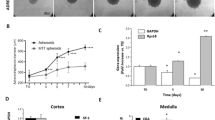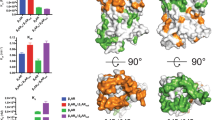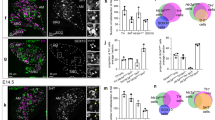Abstract
IT is now a well-established fact that adrenal chromaffin cells of many vertebrates store substantial quantities of both adrenaline and noradrenaline. The relative proportions of the two catecholamines in the normal adult animal is species specific.
This is a preview of subscription content, access via your institution
Access options
Subscribe to this journal
Receive 51 print issues and online access
$199.00 per year
only $3.90 per issue
Buy this article
- Purchase on SpringerLink
- Instant access to full article PDF
Prices may be subject to local taxes which are calculated during checkout
Similar content being viewed by others
References
Hillarp, N.-Å., and Hökfelt, B., Acta Physiol. Scand., 30, 55 (1953).
Eränkö, O., Nature, 175, 88 (1955).
Coupland, R. E., Anat. Soc. Gt. Brit. Symp. Cytology of Nervous Tissue, 28 (Taylor and Francis, 1961); Ann. N. Y. Acad. Sci., 103, 139 (1963).
Wood, J., Amer. J. Anat., 112, 285 (1963).
Author information
Authors and Affiliations
Rights and permissions
About this article
Cite this article
COUPLAND, R., PYPER, A. & HOPWOOD, D. A Method for Differentiating between Noradrenaline- and Adrenaline-storing Cells in the Light and Electron Microscope. Nature 201, 1240–1242 (1964). https://doi.org/10.1038/2011240b0
Issue date:
DOI: https://doi.org/10.1038/2011240b0
This article is cited by
-
Old and emerging concepts on adrenal chromaffin cell stimulus-secretion coupling
Pflügers Archiv - European Journal of Physiology (2018)
-
Single-cell fura-2 microfluorometry reveals different purinoceptor subtypes coupled to Ca2+ influx and intracellular Ca2+ release in bovine adrenal chromaffin and endothelial cells
Pfl�gers Archiv European Journal of Physiology (1994)
-
Quantitative X-ray microanalysis of adrenal medullary cells of young adult and aged rats after glutaraldehyde fixation and potassium dichromate treatment
Histochemistry (1993)
-
Giant granules in adrenaline-secreting chromaffin cells of lizard adrenal glands after metyrapone administration
Experientia (1980)
-
Changes in blood catecholamine levels and ultrastructure of dog adrenal medullary cells during hemorrhagic shock
Virchows Archiv B Cell Pathology (1977)



